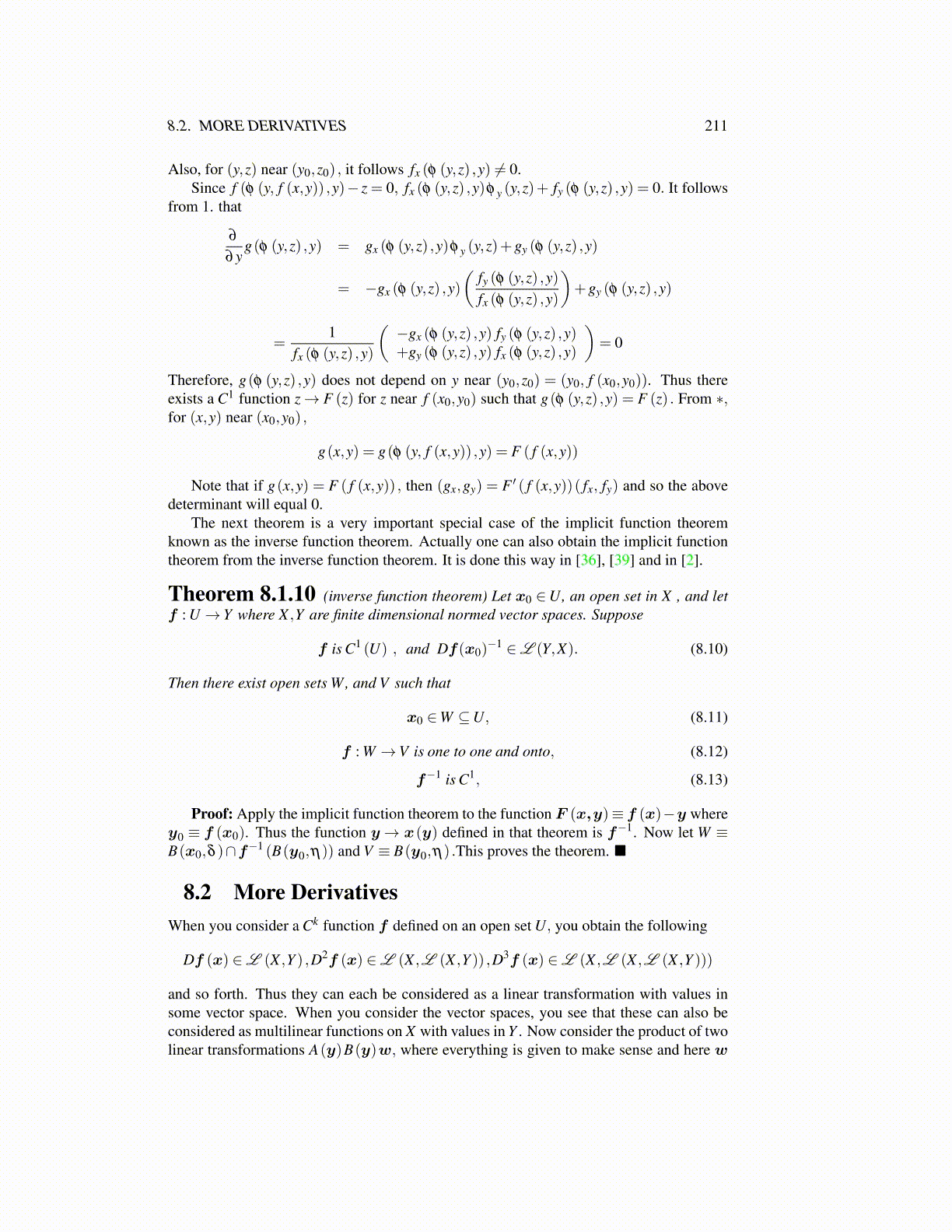
8.2. MORE DERIVATIVES 211
Also, for (y,z) near (y0,z0) , it follows fx (φ (y,z) ,y) ̸= 0.Since f (φ (y, f (x,y)) ,y)− z = 0, fx (φ (y,z) ,y)φ y (y,z)+ fy (φ (y,z) ,y) = 0. It follows
from 1. that
∂
∂yg(φ (y,z) ,y) = gx (φ (y,z) ,y)φ y (y,z)+gy (φ (y,z) ,y)
= −gx (φ (y,z) ,y)(
fy (φ (y,z) ,y)fx (φ (y,z) ,y)
)+gy (φ (y,z) ,y)
=1
fx (φ (y,z) ,y)
(−gx (φ (y,z) ,y) fy (φ (y,z) ,y)+gy (φ (y,z) ,y) fx (φ (y,z) ,y)
)= 0
Therefore, g(φ (y,z) ,y) does not depend on y near (y0,z0) = (y0, f (x0,y0)). Thus thereexists a C1 function z→ F (z) for z near f (x0,y0) such that g(φ (y,z) ,y) = F (z) . From ∗,for (x,y) near (x0,y0) ,
g(x,y) = g(φ (y, f (x,y)) ,y) = F ( f (x,y))
Note that if g(x,y) = F ( f (x,y)) , then (gx,gy) = F ′ ( f (x,y))( fx, fy) and so the abovedeterminant will equal 0.
The next theorem is a very important special case of the implicit function theoremknown as the inverse function theorem. Actually one can also obtain the implicit functiontheorem from the inverse function theorem. It is done this way in [36], [39] and in [2].
Theorem 8.1.10 (inverse function theorem) Let x0 ∈U, an open set in X , and letf : U → Y where X ,Y are finite dimensional normed vector spaces. Suppose
f is C1 (U) , and Df(x0)−1 ∈L (Y,X). (8.10)
Then there exist open sets W, and V such that
x0 ∈W ⊆U, (8.11)
f : W →V is one to one and onto, (8.12)
f−1 is C1, (8.13)
Proof: Apply the implicit function theorem to the function F (x,y)≡ f (x)−y wherey0 ≡ f (x0). Thus the function y→ x(y) defined in that theorem is f−1. Now let W ≡B(x0,δ )∩f−1 (B(y0,η)) and V ≡ B(y0,η) .This proves the theorem. ■
8.2 More DerivativesWhen you consider a Ck function f defined on an open set U, you obtain the following
Df (x) ∈L (X ,Y ) ,D2f (x) ∈L (X ,L (X ,Y )) ,D3f (x) ∈L (X ,L (X ,L (X ,Y )))
and so forth. Thus they can each be considered as a linear transformation with values insome vector space. When you consider the vector spaces, you see that these can also beconsidered as multilinear functions on X with values in Y . Now consider the product of twolinear transformations A(y)B(y)w, where everything is given to make sense and here w